FNSACC506 - Internal Controls: Case Study Analysis & Procedures
VerifiedAdded on 2023/05/27
|37
|9777
|231
Case Study
AI Summary
This assignment presents a detailed case study on internal controls, addressing key knowledge requirements through short answer questions, practical exercises, and case study analysis. It covers topics such as the collapse of Barings Bank PLC, fraud detection in accounting systems, and controls in computer information systems (CIS). The assignment examines the importance of proper supervision, segregation of duties, and the implementation of internal control procedures to prevent fraud and inefficiency. It also explores the organizational structure concerns within CIS, the differences between CIS and manual accounting systems, and the advantages and disadvantages of using modern database systems. Performance indicators (KPIs) are developed to aid in the early detection of fraud, and recommendations are made to improve internal control processes. The document is submitted by a student and available on Desklib.
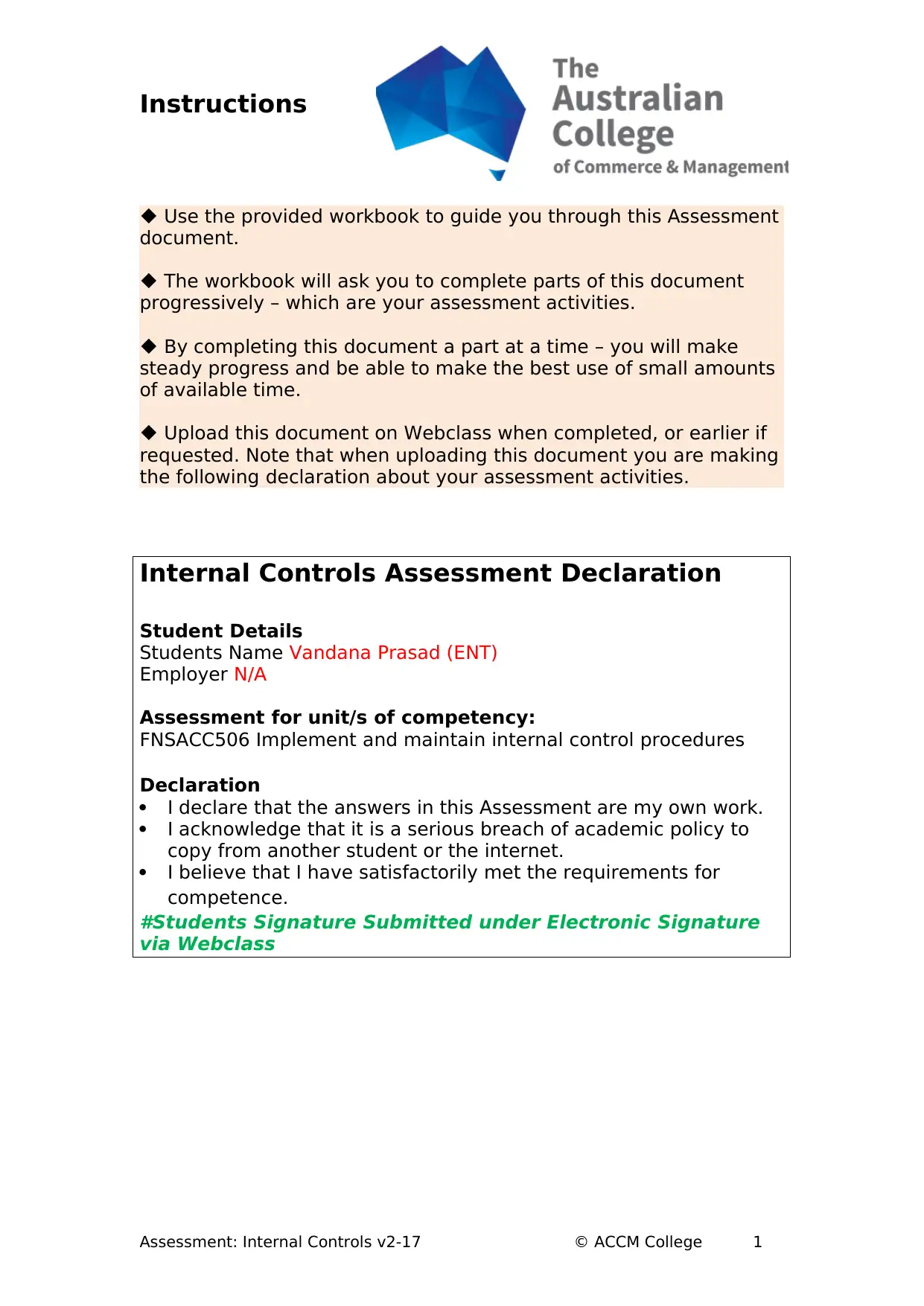
Instructions
Use the provided workbook to guide you through this Assessment
document.
The workbook will ask you to complete parts of this document
progressively – which are your assessment activities.
By completing this document a part at a time – you will make
steady progress and be able to make the best use of small amounts
of available time.
Upload this document on Webclass when completed, or earlier if
requested. Note that when uploading this document you are making
the following declaration about your assessment activities.
Internal Controls Assessment Declaration
Student Details
Students Name Vandana Prasad (ENT)
Employer N/A
Assessment for unit/s of competency:
FNSACC506 Implement and maintain internal control procedures
Declaration
I declare that the answers in this Assessment are my own work.
I acknowledge that it is a serious breach of academic policy to
copy from another student or the internet.
I believe that I have satisfactorily met the requirements for
competence.
#Students Signature Submitted under Electronic Signature
via Webclass
Assessment: Internal Controls v2-17 Vandana Prasad © ACCM College 1
Use the provided workbook to guide you through this Assessment
document.
The workbook will ask you to complete parts of this document
progressively – which are your assessment activities.
By completing this document a part at a time – you will make
steady progress and be able to make the best use of small amounts
of available time.
Upload this document on Webclass when completed, or earlier if
requested. Note that when uploading this document you are making
the following declaration about your assessment activities.
Internal Controls Assessment Declaration
Student Details
Students Name Vandana Prasad (ENT)
Employer N/A
Assessment for unit/s of competency:
FNSACC506 Implement and maintain internal control procedures
Declaration
I declare that the answers in this Assessment are my own work.
I acknowledge that it is a serious breach of academic policy to
copy from another student or the internet.
I believe that I have satisfactorily met the requirements for
competence.
#Students Signature Submitted under Electronic Signature
via Webclass
Assessment: Internal Controls v2-17 Vandana Prasad © ACCM College 1
Paraphrase This Document
Need a fresh take? Get an instant paraphrase of this document with our AI Paraphraser
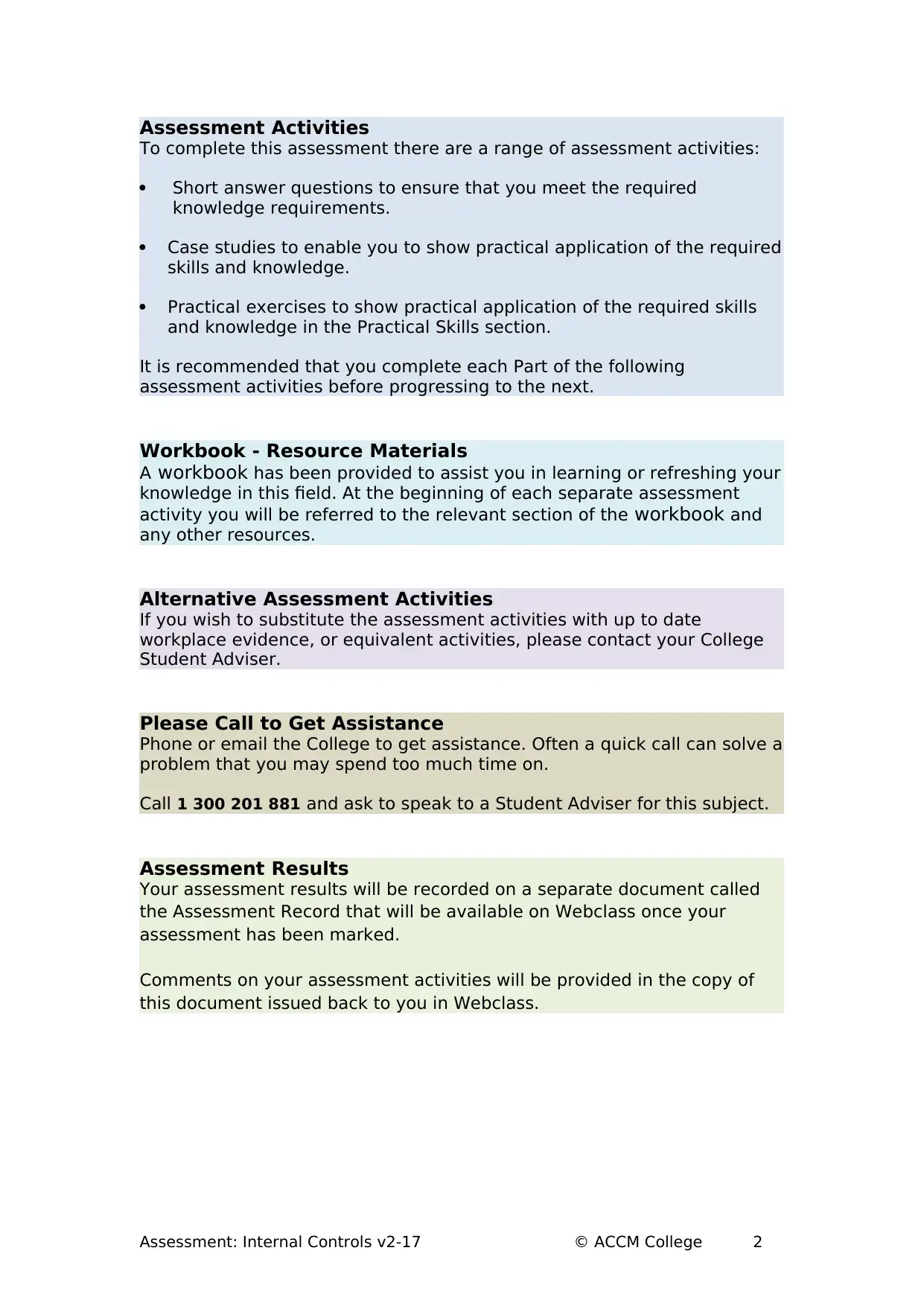
Assessment Activities
To complete this assessment there are a range of assessment activities:
Short answer questions to ensure that you meet the required
knowledge requirements.
Case studies to enable you to show practical application of the required
skills and knowledge.
Practical exercises to show practical application of the required skills
and knowledge in the Practical Skills section.
It is recommended that you complete each Part of the following
assessment activities before progressing to the next.
Workbook - Resource Materials
A workbook has been provided to assist you in learning or refreshing your
knowledge in this field. At the beginning of each separate assessment
activity you will be referred to the relevant section of the workbook and
any other resources.
Alternative Assessment Activities
If you wish to substitute the assessment activities with up to date
workplace evidence, or equivalent activities, please contact your College
Student Adviser.
Please Call to Get Assistance
Phone or email the College to get assistance. Often a quick call can solve a
problem that you may spend too much time on.
Call 1 300 201 881 and ask to speak to a Student Adviser for this subject.
Assessment Results
Your assessment results will be recorded on a separate document called
the Assessment Record that will be available on Webclass once your
assessment has been marked.
Comments on your assessment activities will be provided in the copy of
this document issued back to you in Webclass.
Assessment: Internal Controls v2-17 Vandana Prasad © ACCM College 2
To complete this assessment there are a range of assessment activities:
Short answer questions to ensure that you meet the required
knowledge requirements.
Case studies to enable you to show practical application of the required
skills and knowledge.
Practical exercises to show practical application of the required skills
and knowledge in the Practical Skills section.
It is recommended that you complete each Part of the following
assessment activities before progressing to the next.
Workbook - Resource Materials
A workbook has been provided to assist you in learning or refreshing your
knowledge in this field. At the beginning of each separate assessment
activity you will be referred to the relevant section of the workbook and
any other resources.
Alternative Assessment Activities
If you wish to substitute the assessment activities with up to date
workplace evidence, or equivalent activities, please contact your College
Student Adviser.
Please Call to Get Assistance
Phone or email the College to get assistance. Often a quick call can solve a
problem that you may spend too much time on.
Call 1 300 201 881 and ask to speak to a Student Adviser for this subject.
Assessment Results
Your assessment results will be recorded on a separate document called
the Assessment Record that will be available on Webclass once your
assessment has been marked.
Comments on your assessment activities will be provided in the copy of
this document issued back to you in Webclass.
Assessment: Internal Controls v2-17 Vandana Prasad © ACCM College 2
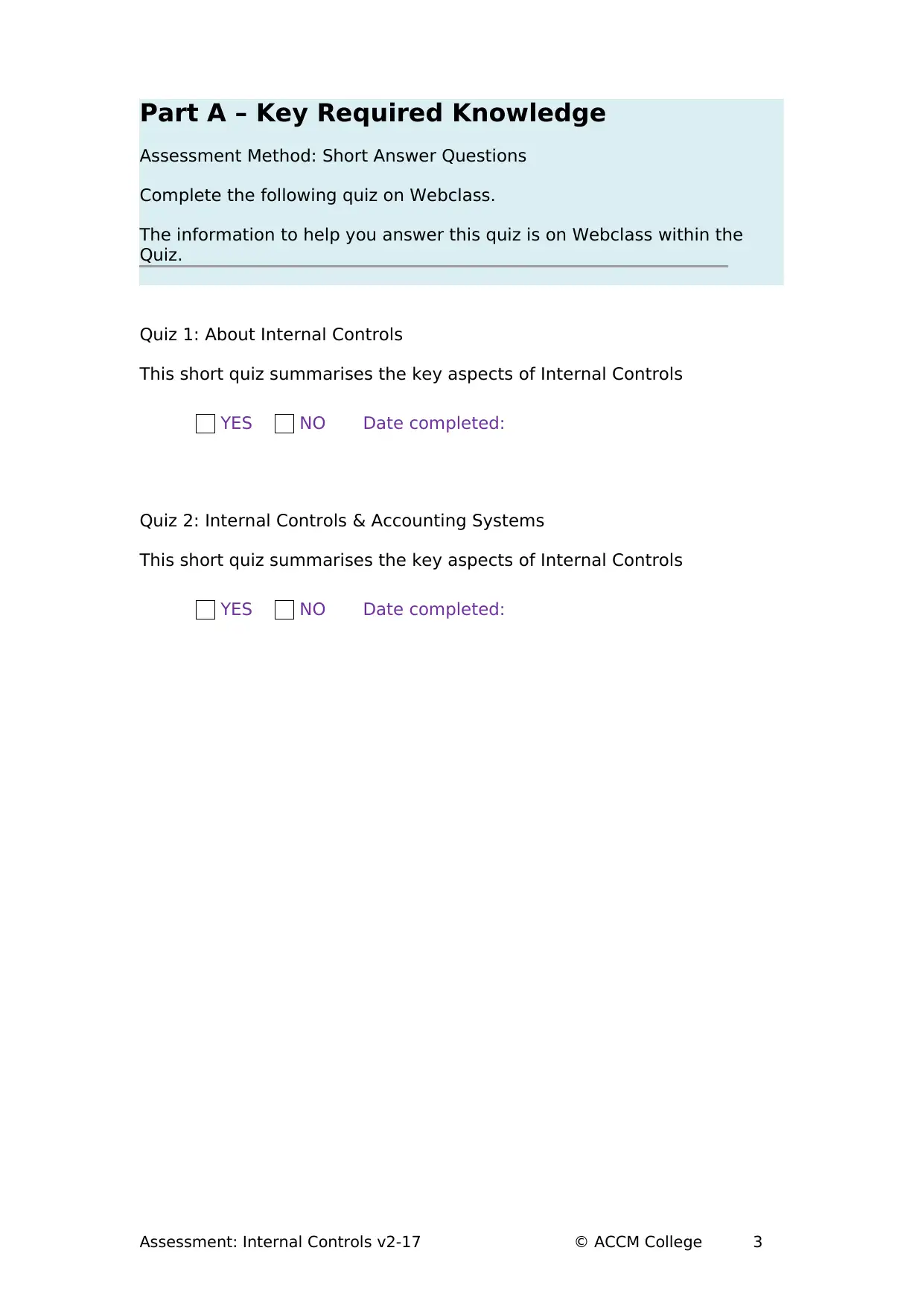
Part A – Key Required Knowledge
Assessment Method: Short Answer Questions
Complete the following quiz on Webclass.
The information to help you answer this quiz is on Webclass within the
Quiz.
Quiz 1: About Internal Controls
This short quiz summarises the key aspects of Internal Controls
YES NO Date completed:
Quiz 2: Internal Controls & Accounting Systems
This short quiz summarises the key aspects of Internal Controls
YES NO Date completed:
Assessment: Internal Controls v2-17 Vandana Prasad © ACCM College 3
Assessment Method: Short Answer Questions
Complete the following quiz on Webclass.
The information to help you answer this quiz is on Webclass within the
Quiz.
Quiz 1: About Internal Controls
This short quiz summarises the key aspects of Internal Controls
YES NO Date completed:
Quiz 2: Internal Controls & Accounting Systems
This short quiz summarises the key aspects of Internal Controls
YES NO Date completed:
Assessment: Internal Controls v2-17 Vandana Prasad © ACCM College 3
⊘ This is a preview!⊘
Do you want full access?
Subscribe today to unlock all pages.

Trusted by 1+ million students worldwide
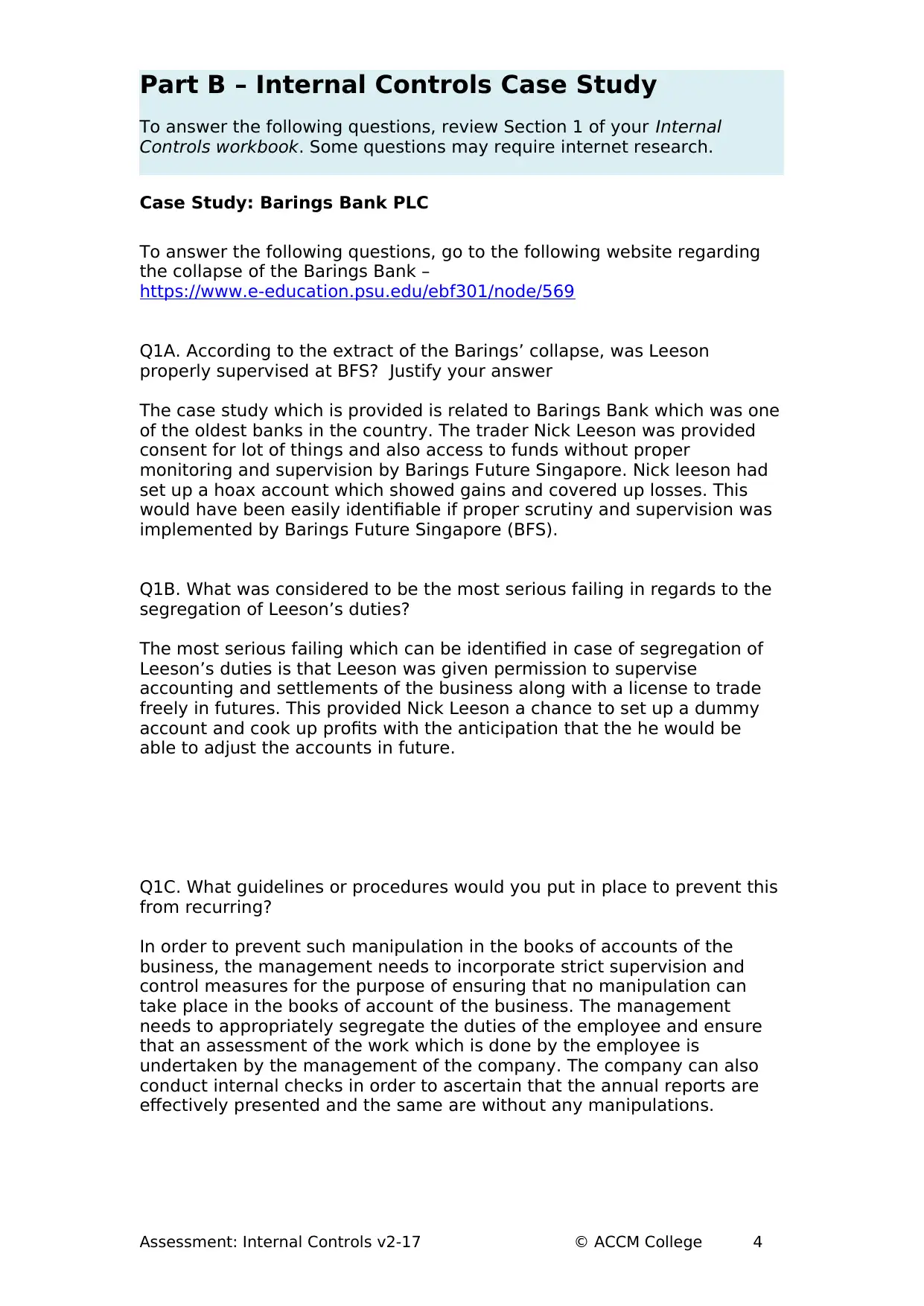
Part B – Internal Controls Case Study
To answer the following questions, review Section 1 of your Internal
Controls workbook. Some questions may require internet research.
Case Study: Barings Bank PLC
To answer the following questions, go to the following website regarding
the collapse of the Barings Bank –
https://www.e-education.psu.edu/ebf301/node/569
Q1A. According to the extract of the Barings’ collapse, was Leeson
properly supervised at BFS? Justify your answer
The case study which is provided is related to Barings Bank which was one
of the oldest banks in the country. The trader Nick Leeson was provided
consent for lot of things and also access to funds without proper
monitoring and supervision by Barings Future Singapore. Nick leeson had
set up a hoax account which showed gains and covered up losses. This
would have been easily identifiable if proper scrutiny and supervision was
implemented by Barings Future Singapore (BFS).
Q1B. What was considered to be the most serious failing in regards to the
segregation of Leeson’s duties?
The most serious failing which can be identified in case of segregation of
Leeson’s duties is that Leeson was given permission to supervise
accounting and settlements of the business along with a license to trade
freely in futures. This provided Nick Leeson a chance to set up a dummy
account and cook up profits with the anticipation that the he would be
able to adjust the accounts in future.
Q1C. What guidelines or procedures would you put in place to prevent this
from recurring?
In order to prevent such manipulation in the books of accounts of the
business, the management needs to incorporate strict supervision and
control measures for the purpose of ensuring that no manipulation can
take place in the books of account of the business. The management
needs to appropriately segregate the duties of the employee and ensure
that an assessment of the work which is done by the employee is
undertaken by the management of the company. The company can also
conduct internal checks in order to ascertain that the annual reports are
effectively presented and the same are without any manipulations.
Assessment: Internal Controls v2-17 Vandana Prasad © ACCM College 4
To answer the following questions, review Section 1 of your Internal
Controls workbook. Some questions may require internet research.
Case Study: Barings Bank PLC
To answer the following questions, go to the following website regarding
the collapse of the Barings Bank –
https://www.e-education.psu.edu/ebf301/node/569
Q1A. According to the extract of the Barings’ collapse, was Leeson
properly supervised at BFS? Justify your answer
The case study which is provided is related to Barings Bank which was one
of the oldest banks in the country. The trader Nick Leeson was provided
consent for lot of things and also access to funds without proper
monitoring and supervision by Barings Future Singapore. Nick leeson had
set up a hoax account which showed gains and covered up losses. This
would have been easily identifiable if proper scrutiny and supervision was
implemented by Barings Future Singapore (BFS).
Q1B. What was considered to be the most serious failing in regards to the
segregation of Leeson’s duties?
The most serious failing which can be identified in case of segregation of
Leeson’s duties is that Leeson was given permission to supervise
accounting and settlements of the business along with a license to trade
freely in futures. This provided Nick Leeson a chance to set up a dummy
account and cook up profits with the anticipation that the he would be
able to adjust the accounts in future.
Q1C. What guidelines or procedures would you put in place to prevent this
from recurring?
In order to prevent such manipulation in the books of accounts of the
business, the management needs to incorporate strict supervision and
control measures for the purpose of ensuring that no manipulation can
take place in the books of account of the business. The management
needs to appropriately segregate the duties of the employee and ensure
that an assessment of the work which is done by the employee is
undertaken by the management of the company. The company can also
conduct internal checks in order to ascertain that the annual reports are
effectively presented and the same are without any manipulations.
Assessment: Internal Controls v2-17 Vandana Prasad © ACCM College 4
Paraphrase This Document
Need a fresh take? Get an instant paraphrase of this document with our AI Paraphraser
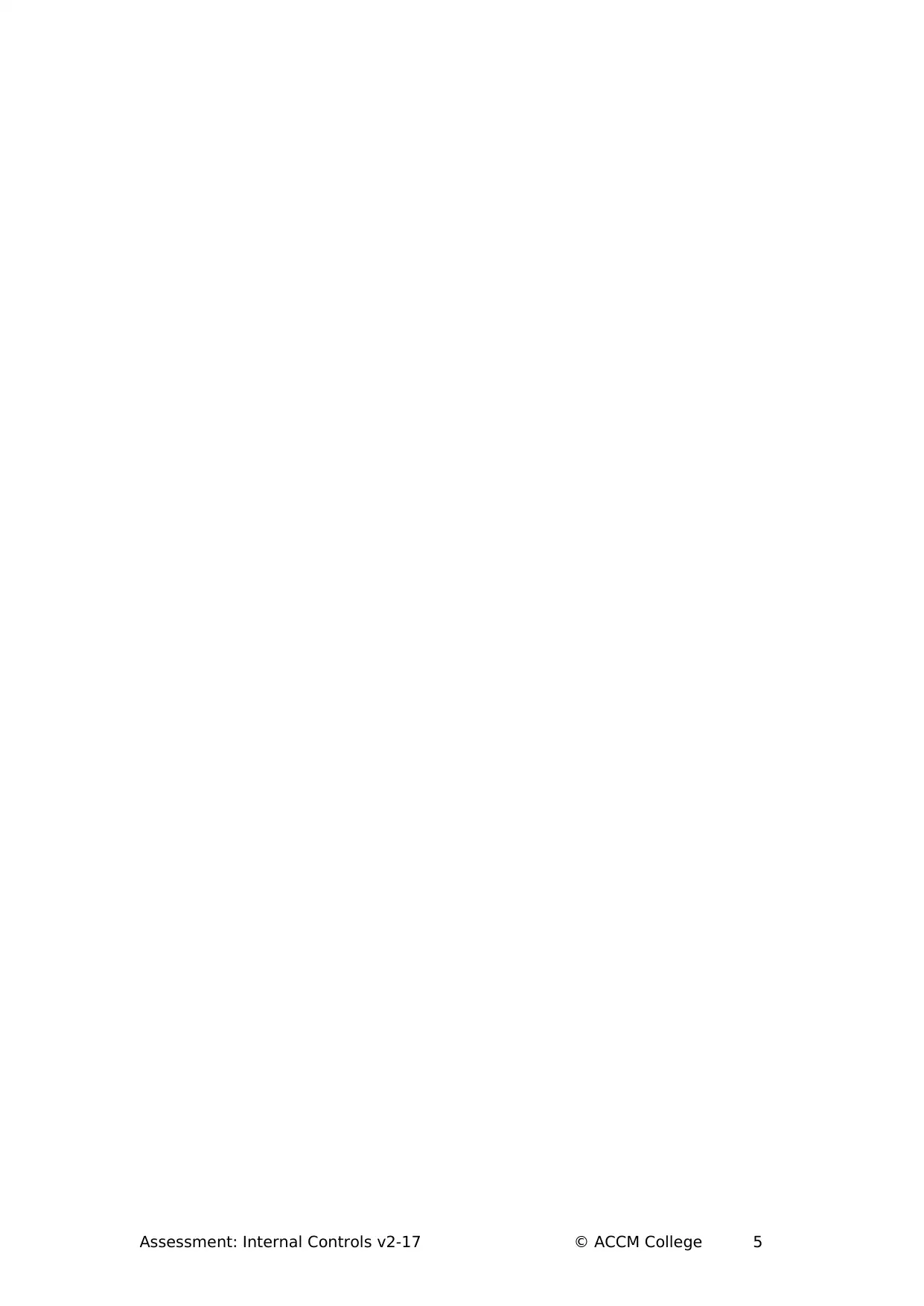
Assessment: Internal Controls v2-17 Vandana Prasad © ACCM College 5
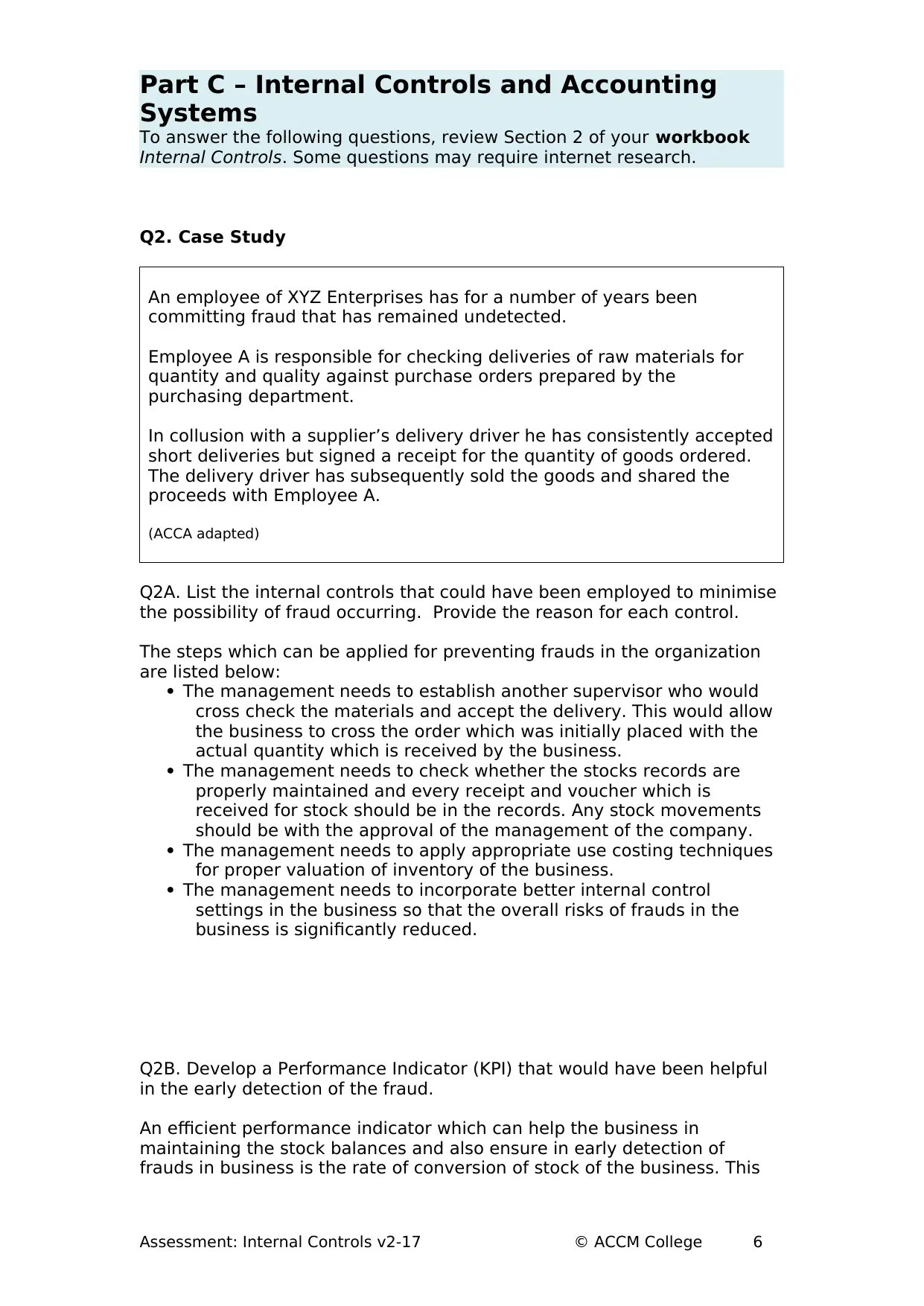
Part C – Internal Controls and Accounting
Systems
To answer the following questions, review Section 2 of your workbook
Internal Controls. Some questions may require internet research.
Q2. Case Study
An employee of XYZ Enterprises has for a number of years been
committing fraud that has remained undetected.
Employee A is responsible for checking deliveries of raw materials for
quantity and quality against purchase orders prepared by the
purchasing department.
In collusion with a supplier’s delivery driver he has consistently accepted
short deliveries but signed a receipt for the quantity of goods ordered.
The delivery driver has subsequently sold the goods and shared the
proceeds with Employee A.
(ACCA adapted)
Q2A. List the internal controls that could have been employed to minimise
the possibility of fraud occurring. Provide the reason for each control.
The steps which can be applied for preventing frauds in the organization
are listed below:
The management needs to establish another supervisor who would
cross check the materials and accept the delivery. This would allow
the business to cross the order which was initially placed with the
actual quantity which is received by the business.
The management needs to check whether the stocks records are
properly maintained and every receipt and voucher which is
received for stock should be in the records. Any stock movements
should be with the approval of the management of the company.
The management needs to apply appropriate use costing techniques
for proper valuation of inventory of the business.
The management needs to incorporate better internal control
settings in the business so that the overall risks of frauds in the
business is significantly reduced.
Q2B. Develop a Performance Indicator (KPI) that would have been helpful
in the early detection of the fraud.
An efficient performance indicator which can help the business in
maintaining the stock balances and also ensure in early detection of
frauds in business is the rate of conversion of stock of the business. This
Assessment: Internal Controls v2-17 Vandana Prasad © ACCM College 6
Systems
To answer the following questions, review Section 2 of your workbook
Internal Controls. Some questions may require internet research.
Q2. Case Study
An employee of XYZ Enterprises has for a number of years been
committing fraud that has remained undetected.
Employee A is responsible for checking deliveries of raw materials for
quantity and quality against purchase orders prepared by the
purchasing department.
In collusion with a supplier’s delivery driver he has consistently accepted
short deliveries but signed a receipt for the quantity of goods ordered.
The delivery driver has subsequently sold the goods and shared the
proceeds with Employee A.
(ACCA adapted)
Q2A. List the internal controls that could have been employed to minimise
the possibility of fraud occurring. Provide the reason for each control.
The steps which can be applied for preventing frauds in the organization
are listed below:
The management needs to establish another supervisor who would
cross check the materials and accept the delivery. This would allow
the business to cross the order which was initially placed with the
actual quantity which is received by the business.
The management needs to check whether the stocks records are
properly maintained and every receipt and voucher which is
received for stock should be in the records. Any stock movements
should be with the approval of the management of the company.
The management needs to apply appropriate use costing techniques
for proper valuation of inventory of the business.
The management needs to incorporate better internal control
settings in the business so that the overall risks of frauds in the
business is significantly reduced.
Q2B. Develop a Performance Indicator (KPI) that would have been helpful
in the early detection of the fraud.
An efficient performance indicator which can help the business in
maintaining the stock balances and also ensure in early detection of
frauds in business is the rate of conversion of stock of the business. This
Assessment: Internal Controls v2-17 Vandana Prasad © ACCM College 6
⊘ This is a preview!⊘
Do you want full access?
Subscribe today to unlock all pages.

Trusted by 1+ million students worldwide
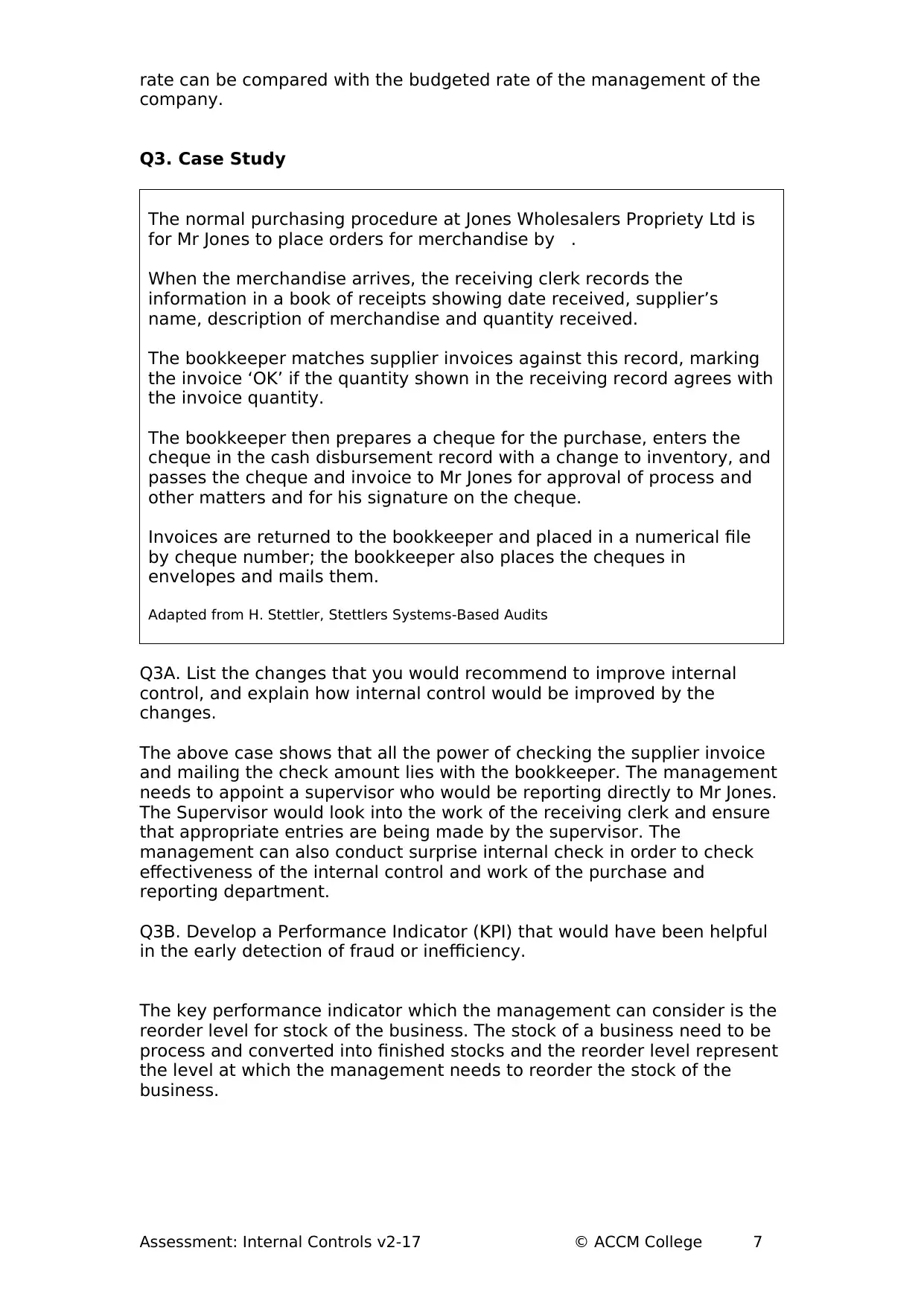
rate can be compared with the budgeted rate of the management of the
company.
Q3. Case Study
The normal purchasing procedure at Jones Wholesalers Propriety Ltd is
for Mr Jones to place orders for merchandise by .
When the merchandise arrives, the receiving clerk records the
information in a book of receipts showing date received, supplier’s
name, description of merchandise and quantity received.
The bookkeeper matches supplier invoices against this record, marking
the invoice ‘OK’ if the quantity shown in the receiving record agrees with
the invoice quantity.
The bookkeeper then prepares a cheque for the purchase, enters the
cheque in the cash disbursement record with a change to inventory, and
passes the cheque and invoice to Mr Jones for approval of process and
other matters and for his signature on the cheque.
Invoices are returned to the bookkeeper and placed in a numerical file
by cheque number; the bookkeeper also places the cheques in
envelopes and mails them.
Adapted from H. Stettler, Stettlers Systems-Based Audits
Q3A. List the changes that you would recommend to improve internal
control, and explain how internal control would be improved by the
changes.
The above case shows that all the power of checking the supplier invoice
and mailing the check amount lies with the bookkeeper. The management
needs to appoint a supervisor who would be reporting directly to Mr Jones.
The Supervisor would look into the work of the receiving clerk and ensure
that appropriate entries are being made by the supervisor. The
management can also conduct surprise internal check in order to check
effectiveness of the internal control and work of the purchase and
reporting department.
Q3B. Develop a Performance Indicator (KPI) that would have been helpful
in the early detection of fraud or inefficiency.
The key performance indicator which the management can consider is the
reorder level for stock of the business. The stock of a business need to be
process and converted into finished stocks and the reorder level represent
the level at which the management needs to reorder the stock of the
business.
Assessment: Internal Controls v2-17 Vandana Prasad © ACCM College 7
company.
Q3. Case Study
The normal purchasing procedure at Jones Wholesalers Propriety Ltd is
for Mr Jones to place orders for merchandise by .
When the merchandise arrives, the receiving clerk records the
information in a book of receipts showing date received, supplier’s
name, description of merchandise and quantity received.
The bookkeeper matches supplier invoices against this record, marking
the invoice ‘OK’ if the quantity shown in the receiving record agrees with
the invoice quantity.
The bookkeeper then prepares a cheque for the purchase, enters the
cheque in the cash disbursement record with a change to inventory, and
passes the cheque and invoice to Mr Jones for approval of process and
other matters and for his signature on the cheque.
Invoices are returned to the bookkeeper and placed in a numerical file
by cheque number; the bookkeeper also places the cheques in
envelopes and mails them.
Adapted from H. Stettler, Stettlers Systems-Based Audits
Q3A. List the changes that you would recommend to improve internal
control, and explain how internal control would be improved by the
changes.
The above case shows that all the power of checking the supplier invoice
and mailing the check amount lies with the bookkeeper. The management
needs to appoint a supervisor who would be reporting directly to Mr Jones.
The Supervisor would look into the work of the receiving clerk and ensure
that appropriate entries are being made by the supervisor. The
management can also conduct surprise internal check in order to check
effectiveness of the internal control and work of the purchase and
reporting department.
Q3B. Develop a Performance Indicator (KPI) that would have been helpful
in the early detection of fraud or inefficiency.
The key performance indicator which the management can consider is the
reorder level for stock of the business. The stock of a business need to be
process and converted into finished stocks and the reorder level represent
the level at which the management needs to reorder the stock of the
business.
Assessment: Internal Controls v2-17 Vandana Prasad © ACCM College 7
Paraphrase This Document
Need a fresh take? Get an instant paraphrase of this document with our AI Paraphraser
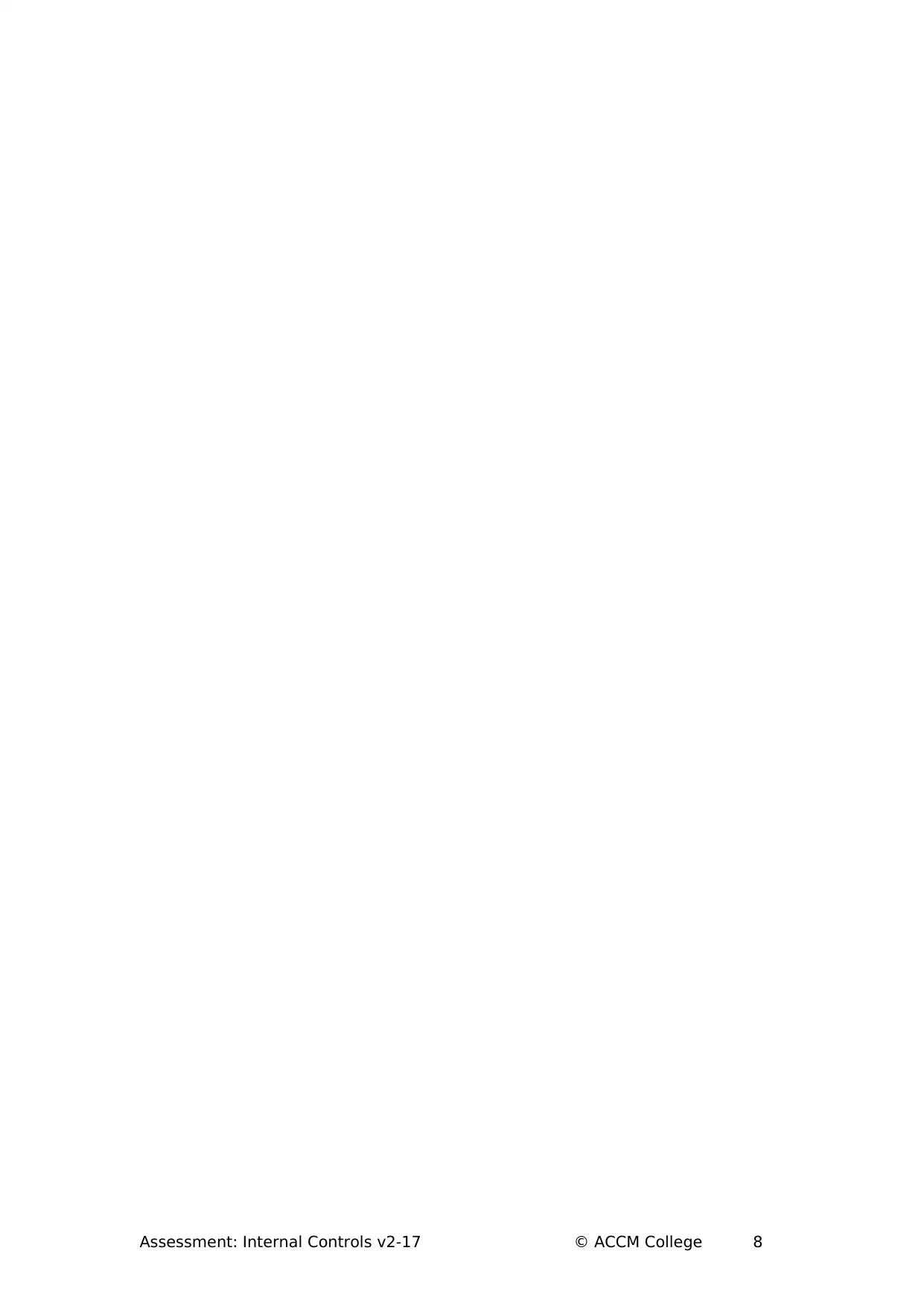
Assessment: Internal Controls v2-17 Vandana Prasad © ACCM College 8
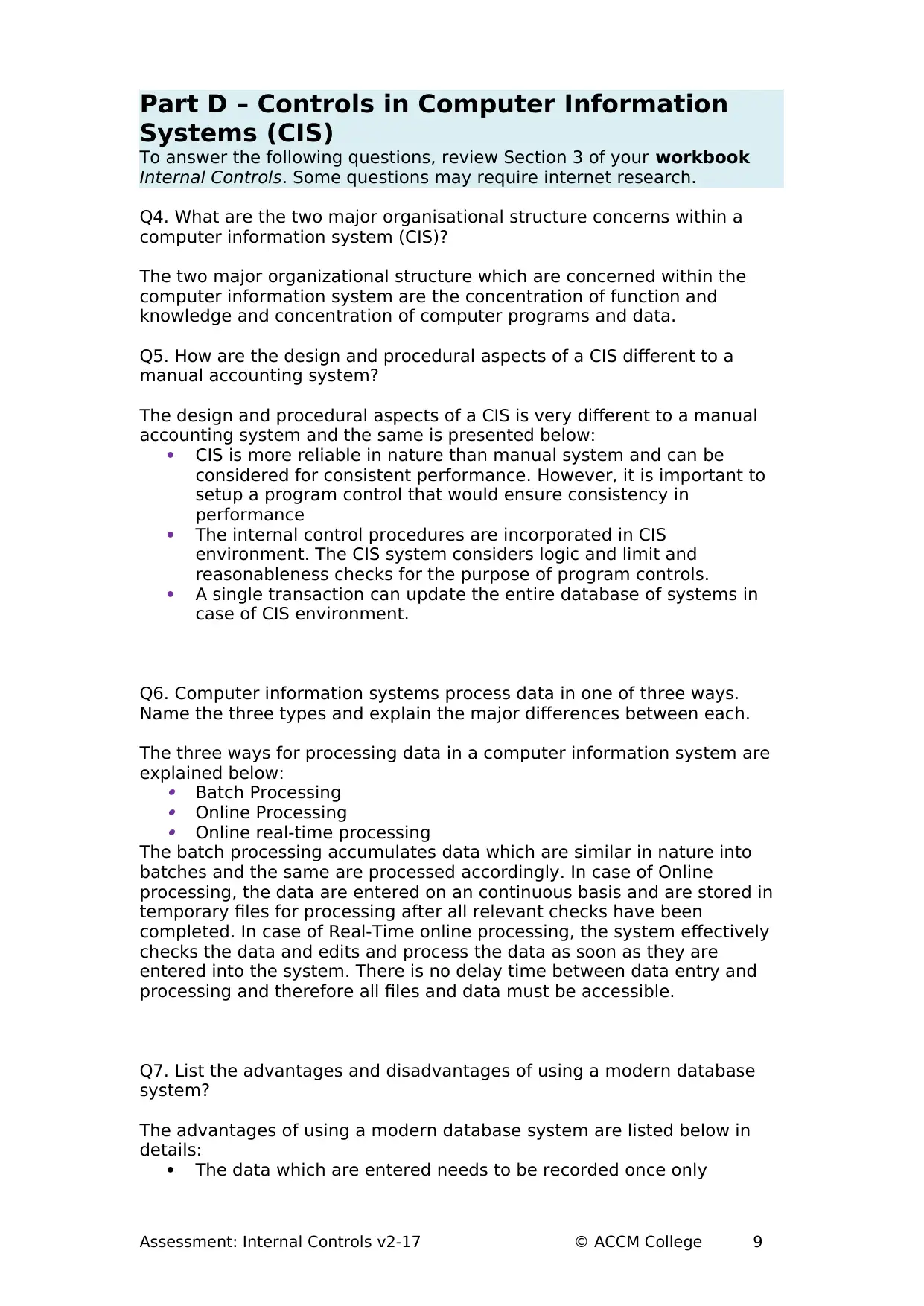
Part D – Controls in Computer Information
Systems (CIS)
To answer the following questions, review Section 3 of your workbook
Internal Controls. Some questions may require internet research.
Q4. What are the two major organisational structure concerns within a
computer information system (CIS)?
The two major organizational structure which are concerned within the
computer information system are the concentration of function and
knowledge and concentration of computer programs and data.
Q5. How are the design and procedural aspects of a CIS different to a
manual accounting system?
The design and procedural aspects of a CIS is very different to a manual
accounting system and the same is presented below:
CIS is more reliable in nature than manual system and can be
considered for consistent performance. However, it is important to
setup a program control that would ensure consistency in
performance
The internal control procedures are incorporated in CIS
environment. The CIS system considers logic and limit and
reasonableness checks for the purpose of program controls.
A single transaction can update the entire database of systems in
case of CIS environment.
Q6. Computer information systems process data in one of three ways.
Name the three types and explain the major differences between each.
The three ways for processing data in a computer information system are
explained below:
Batch Processing
Online Processing
Online real-time processing
The batch processing accumulates data which are similar in nature into
batches and the same are processed accordingly. In case of Online
processing, the data are entered on an continuous basis and are stored in
temporary files for processing after all relevant checks have been
completed. In case of Real-Time online processing, the system effectively
checks the data and edits and process the data as soon as they are
entered into the system. There is no delay time between data entry and
processing and therefore all files and data must be accessible.
Q7. List the advantages and disadvantages of using a modern database
system?
The advantages of using a modern database system are listed below in
details:
The data which are entered needs to be recorded once only
Assessment: Internal Controls v2-17 Vandana Prasad © ACCM College 9
Systems (CIS)
To answer the following questions, review Section 3 of your workbook
Internal Controls. Some questions may require internet research.
Q4. What are the two major organisational structure concerns within a
computer information system (CIS)?
The two major organizational structure which are concerned within the
computer information system are the concentration of function and
knowledge and concentration of computer programs and data.
Q5. How are the design and procedural aspects of a CIS different to a
manual accounting system?
The design and procedural aspects of a CIS is very different to a manual
accounting system and the same is presented below:
CIS is more reliable in nature than manual system and can be
considered for consistent performance. However, it is important to
setup a program control that would ensure consistency in
performance
The internal control procedures are incorporated in CIS
environment. The CIS system considers logic and limit and
reasonableness checks for the purpose of program controls.
A single transaction can update the entire database of systems in
case of CIS environment.
Q6. Computer information systems process data in one of three ways.
Name the three types and explain the major differences between each.
The three ways for processing data in a computer information system are
explained below:
Batch Processing
Online Processing
Online real-time processing
The batch processing accumulates data which are similar in nature into
batches and the same are processed accordingly. In case of Online
processing, the data are entered on an continuous basis and are stored in
temporary files for processing after all relevant checks have been
completed. In case of Real-Time online processing, the system effectively
checks the data and edits and process the data as soon as they are
entered into the system. There is no delay time between data entry and
processing and therefore all files and data must be accessible.
Q7. List the advantages and disadvantages of using a modern database
system?
The advantages of using a modern database system are listed below in
details:
The data which are entered needs to be recorded once only
Assessment: Internal Controls v2-17 Vandana Prasad © ACCM College 9
⊘ This is a preview!⊘
Do you want full access?
Subscribe today to unlock all pages.

Trusted by 1+ million students worldwide
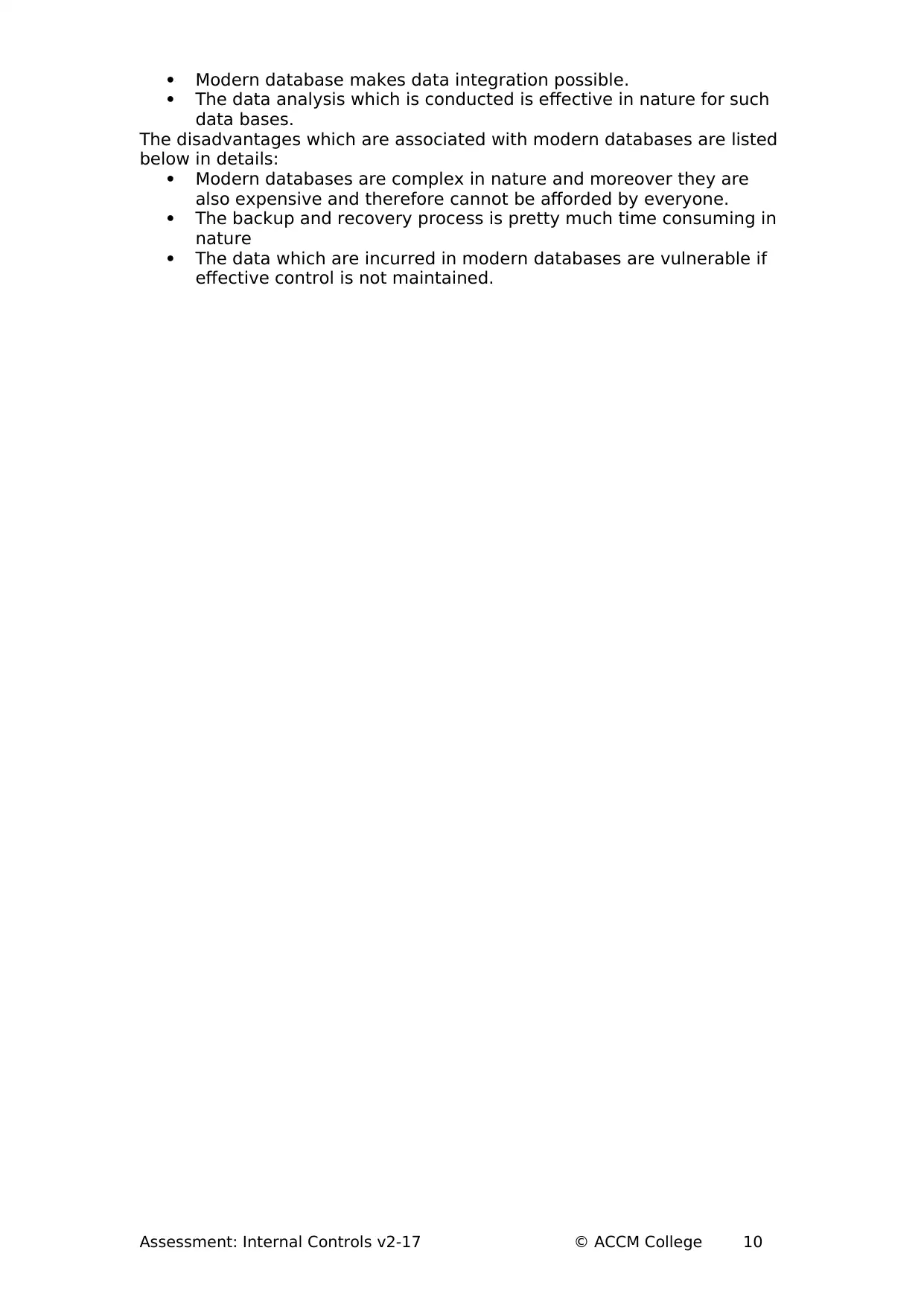
Modern database makes data integration possible.
The data analysis which is conducted is effective in nature for such
data bases.
The disadvantages which are associated with modern databases are listed
below in details:
Modern databases are complex in nature and moreover they are
also expensive and therefore cannot be afforded by everyone.
The backup and recovery process is pretty much time consuming in
nature
The data which are incurred in modern databases are vulnerable if
effective control is not maintained.
Assessment: Internal Controls v2-17 Vandana Prasad © ACCM College 10
The data analysis which is conducted is effective in nature for such
data bases.
The disadvantages which are associated with modern databases are listed
below in details:
Modern databases are complex in nature and moreover they are
also expensive and therefore cannot be afforded by everyone.
The backup and recovery process is pretty much time consuming in
nature
The data which are incurred in modern databases are vulnerable if
effective control is not maintained.
Assessment: Internal Controls v2-17 Vandana Prasad © ACCM College 10
Paraphrase This Document
Need a fresh take? Get an instant paraphrase of this document with our AI Paraphraser
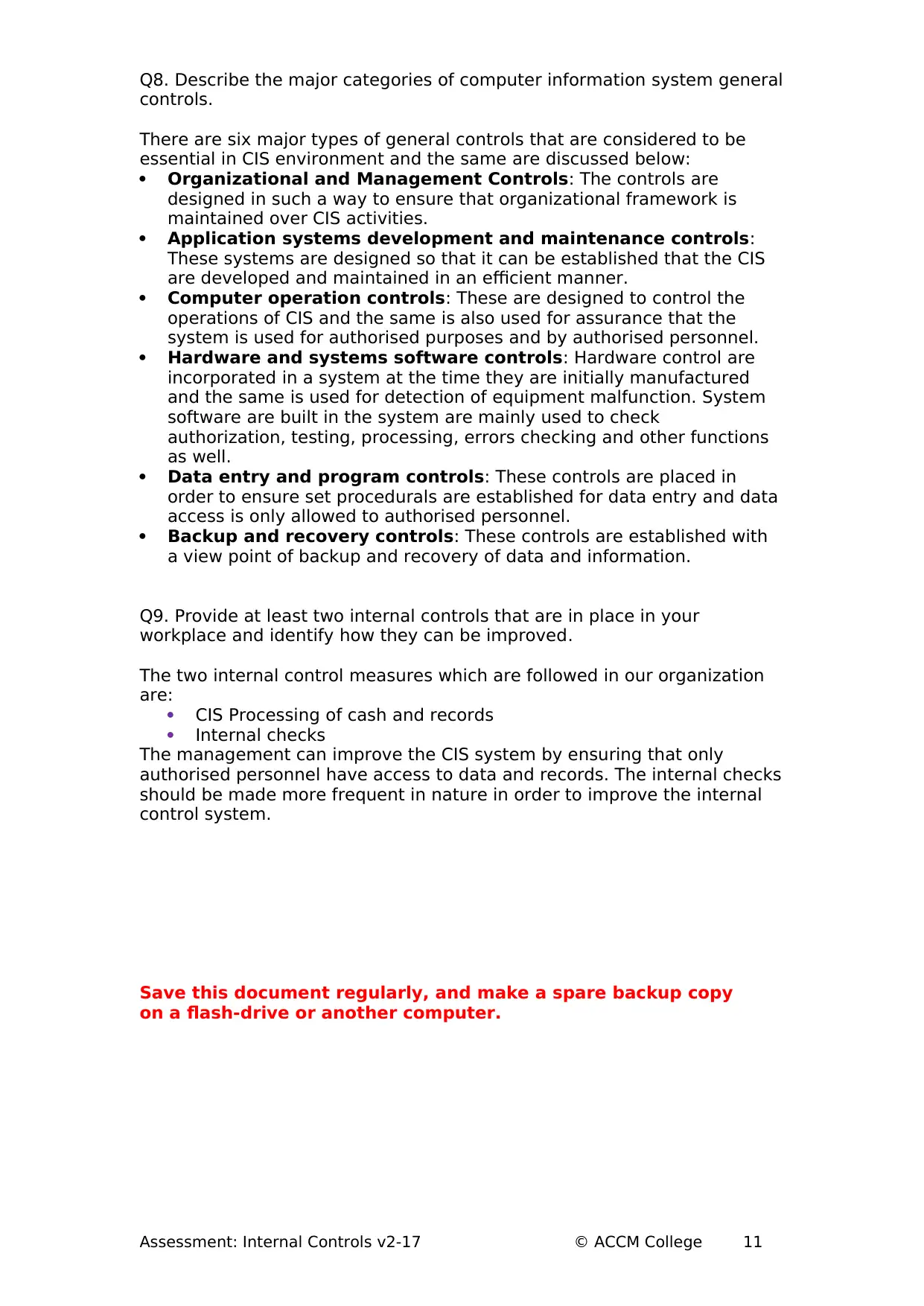
Q8. Describe the major categories of computer information system general
controls.
There are six major types of general controls that are considered to be
essential in CIS environment and the same are discussed below:
Organizational and Management Controls: The controls are
designed in such a way to ensure that organizational framework is
maintained over CIS activities.
Application systems development and maintenance controls:
These systems are designed so that it can be established that the CIS
are developed and maintained in an efficient manner.
Computer operation controls: These are designed to control the
operations of CIS and the same is also used for assurance that the
system is used for authorised purposes and by authorised personnel.
Hardware and systems software controls: Hardware control are
incorporated in a system at the time they are initially manufactured
and the same is used for detection of equipment malfunction. System
software are built in the system are mainly used to check
authorization, testing, processing, errors checking and other functions
as well.
Data entry and program controls: These controls are placed in
order to ensure set procedurals are established for data entry and data
access is only allowed to authorised personnel.
Backup and recovery controls: These controls are established with
a view point of backup and recovery of data and information.
Q9. Provide at least two internal controls that are in place in your
workplace and identify how they can be improved.
The two internal control measures which are followed in our organization
are:
CIS Processing of cash and records
Internal checks
The management can improve the CIS system by ensuring that only
authorised personnel have access to data and records. The internal checks
should be made more frequent in nature in order to improve the internal
control system.
Save this document regularly, and make a spare backup copy
on a flash-drive or another computer.
Assessment: Internal Controls v2-17 Vandana Prasad © ACCM College 11
controls.
There are six major types of general controls that are considered to be
essential in CIS environment and the same are discussed below:
Organizational and Management Controls: The controls are
designed in such a way to ensure that organizational framework is
maintained over CIS activities.
Application systems development and maintenance controls:
These systems are designed so that it can be established that the CIS
are developed and maintained in an efficient manner.
Computer operation controls: These are designed to control the
operations of CIS and the same is also used for assurance that the
system is used for authorised purposes and by authorised personnel.
Hardware and systems software controls: Hardware control are
incorporated in a system at the time they are initially manufactured
and the same is used for detection of equipment malfunction. System
software are built in the system are mainly used to check
authorization, testing, processing, errors checking and other functions
as well.
Data entry and program controls: These controls are placed in
order to ensure set procedurals are established for data entry and data
access is only allowed to authorised personnel.
Backup and recovery controls: These controls are established with
a view point of backup and recovery of data and information.
Q9. Provide at least two internal controls that are in place in your
workplace and identify how they can be improved.
The two internal control measures which are followed in our organization
are:
CIS Processing of cash and records
Internal checks
The management can improve the CIS system by ensuring that only
authorised personnel have access to data and records. The internal checks
should be made more frequent in nature in order to improve the internal
control system.
Save this document regularly, and make a spare backup copy
on a flash-drive or another computer.
Assessment: Internal Controls v2-17 Vandana Prasad © ACCM College 11
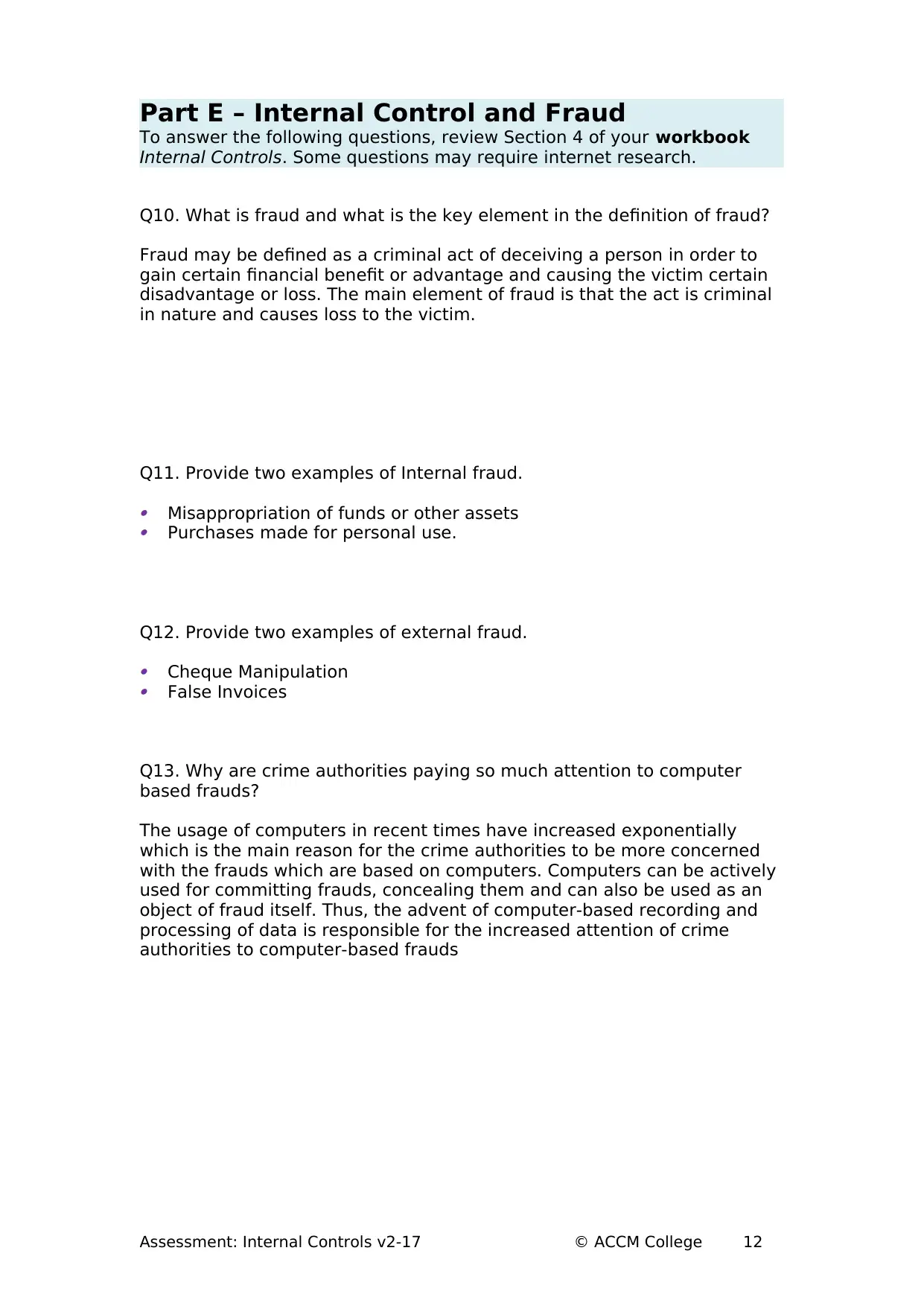
Part E – Internal Control and Fraud
To answer the following questions, review Section 4 of your workbook
Internal Controls. Some questions may require internet research.
Q10. What is fraud and what is the key element in the definition of fraud?
Fraud may be defined as a criminal act of deceiving a person in order to
gain certain financial benefit or advantage and causing the victim certain
disadvantage or loss. The main element of fraud is that the act is criminal
in nature and causes loss to the victim.
Q11. Provide two examples of Internal fraud. Misappropriation of funds or other assets
Purchases made for personal use.
Q12. Provide two examples of external fraud. Cheque Manipulation
False Invoices
Q13. Why are crime authorities paying so much attention to computer
based frauds?
The usage of computers in recent times have increased exponentially
which is the main reason for the crime authorities to be more concerned
with the frauds which are based on computers. Computers can be actively
used for committing frauds, concealing them and can also be used as an
object of fraud itself. Thus, the advent of computer-based recording and
processing of data is responsible for the increased attention of crime
authorities to computer-based frauds
Assessment: Internal Controls v2-17 Vandana Prasad © ACCM College 12
To answer the following questions, review Section 4 of your workbook
Internal Controls. Some questions may require internet research.
Q10. What is fraud and what is the key element in the definition of fraud?
Fraud may be defined as a criminal act of deceiving a person in order to
gain certain financial benefit or advantage and causing the victim certain
disadvantage or loss. The main element of fraud is that the act is criminal
in nature and causes loss to the victim.
Q11. Provide two examples of Internal fraud. Misappropriation of funds or other assets
Purchases made for personal use.
Q12. Provide two examples of external fraud. Cheque Manipulation
False Invoices
Q13. Why are crime authorities paying so much attention to computer
based frauds?
The usage of computers in recent times have increased exponentially
which is the main reason for the crime authorities to be more concerned
with the frauds which are based on computers. Computers can be actively
used for committing frauds, concealing them and can also be used as an
object of fraud itself. Thus, the advent of computer-based recording and
processing of data is responsible for the increased attention of crime
authorities to computer-based frauds
Assessment: Internal Controls v2-17 Vandana Prasad © ACCM College 12
⊘ This is a preview!⊘
Do you want full access?
Subscribe today to unlock all pages.

Trusted by 1+ million students worldwide
1 out of 37
Related Documents
Your All-in-One AI-Powered Toolkit for Academic Success.
+13062052269
info@desklib.com
Available 24*7 on WhatsApp / Email
![[object Object]](/_next/static/media/star-bottom.7253800d.svg)
Unlock your academic potential
Copyright © 2020–2025 A2Z Services. All Rights Reserved. Developed and managed by ZUCOL.




